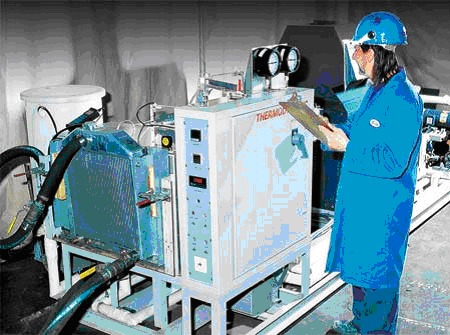|
Aluminum vs. Copper / Brass article by U S Radiator |
 |
|
The thermal conductivity or heat transfer rate of copper is 92% versus aluminum which is approximately 49%. However, the copper fin bonded to the tubes, or water passages, using lead solder is very inefficient and slows the heat transfer rate to just slightly better than that of aluminum. This can be a disadvantage of copper if the bonding process does not allow the copper fin to touch the brass tube, and why not all copper/brass cores of similar design, but different manufactures, transfer heat equally. Copper/brass radiators, because of their weight and durability, have been around a long time and can be easily disassembled and reassembled for cleaning purposes. Not the case with aluminum, unless speaking of the O.E. version that comes with crimp mounted plastic tanks. As a result the life expectancy of the aftermarket aluminum radiators will be far less than that of copper/brass. To better understand the function and performance of any given radiator it helps to understand the “cooling” process and think of it in a way that allows for comparison. The words cooling, or better cooling, or efficient cooling are thrown around a lot in advertising and promotional terms but for the most part un-quantifiable at best without a reference or yardstick to measure by. To measure and control the cooling processes you have to take several variables into consideration. Variables include engine temperature production at different rpm’s, or engine operating btu output, coolant absorption rates, coolant flow rates, or gpm’s, and coolant temperature reduction rates that will vary with the size of the radiator and the amount of (cfm’s), speed, and temperature of the air flowing through the radiator. The only device to actually compare one radiator vs. another with absolute control is to have a wind-tunnel that can duplicate actual driving conditions under various specified conditions. U.S. Radiator built radiator dyno or test stand in 1999 and tested every core design and manufacturer, in both copper/brass and aluminum, for plain and simple temperature drop, inlet to outlet, at specific and controlled parameters |
 |
|
So what did U.S. Radiator learn? First and foremost, they discovered that where the radiator is concerned core design and NOT material had the greatest effect on temperature drop. While all radiator cores might look the same they perform differently based on tube spacing and fins per inch. Heat transfer points where temperature is actually allowed to leave the radiator are where the fin is bonded to the tube. The more transfer points, the greater the temperature drop. A 60’s core for example had a 1/2” tube spacing (ie, 1/2” fin between the tubes) and by going from a two row radiator to a four row core design they were able to double the heat transfer points which resulted in a 15-20% increase in temperature drop without changing the other variables (air flow, coolant flow). In the 80's the Japanese came out with a core design in response to the need to down size, which has become the standard, and was efficient enough to allow the re-introduction of aluminum (a less efficient heat transfer material) at the O.E. level. By changing the tube spacing to 3/8", a design referred to as High Efficiency in the industry, more tubes or water passages and fins were allowed across the face of a core with a specific width in inches. The design was simple enough but proved to be very efficient in that more heat transfer points created greater temperature drop inlet to outlet. At this point the move to aluminum construction was purely financial in that raw materials are purchased “by the pound” and a finished aluminum radiator weighs about 25% of a copper/brass unit (dollars per pound being almost equal at that time) and resulted in huge savings to the O.E.’s . This is why we’ve seen most copper/brass manufacturers either switch to aluminum or fold up their tents permanently. It is important to note that this decision was based solely on financial savings and should not be confused with more efficient. You can get either aluminum or copper / brass radiators at www.CoolCraft.com |
